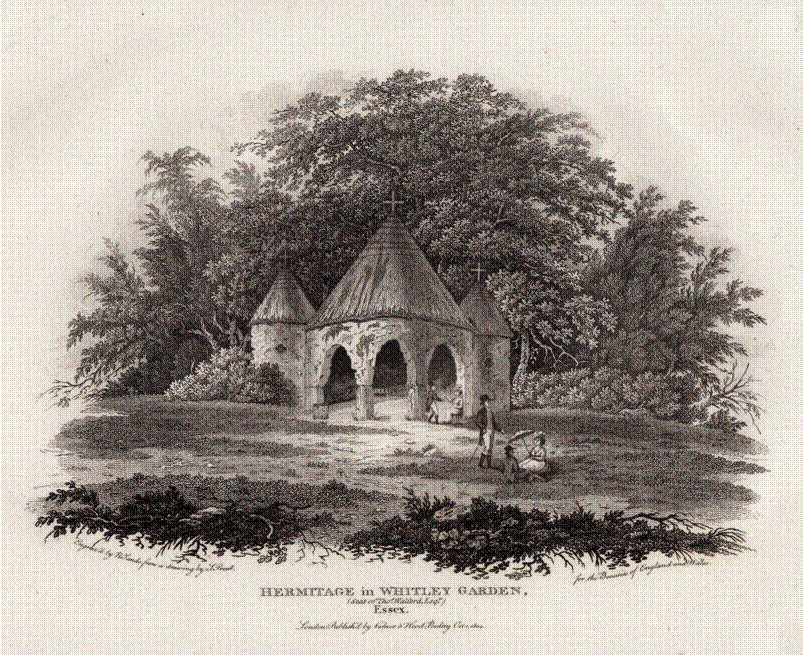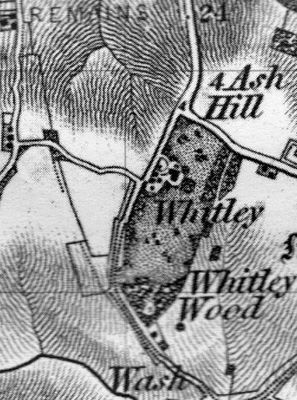Whitley & The Walfords
The following description comes from 'The New British Traveller' by James Dugdale, 1819:
WHITLEY.]-In the parish of Birdbrook, and almost centrically situated between Birdbrook, Baythorne End, and Ridgwell, stands Whitley, the property and residence of Thomas Walford, Esq. who has greatly embellished and improved the estate by various ornamental plantations. A screen of firs and forest trees, combined with sycamores, chestnuts, larches, & c. extends from the house to a small hill, planted with cedars, cypresses, and laurels. "The prospect hence, commanding some fine scenery, is enlivened by the grand embattled Castle of Hedingham, and the Churches of Toppesfield, Ridgwell, and Birdbrook. At a short distance is a wood of about seven acres, laid out in pleasant walks, and ornamented with various seats and buildings. One of them, called the hermitage, agreeably situated amongst the trees, consists of three circular apartments. It is built with wrag-stone, timber, and the bark of trees: the whole covered with thatch, paved with pebbles and tiles, and rusticated with moss, & c. Several other rural and ornamental scenes and objects are met with in these grounds. The flower-garden comprises a rich and choice assemblage of exotic shrubs and flowers, besides a collection of rare English plants : this spot is decorated with a building, named the Temple of Flora, and a summer-house, fancifully ornamented with trellis-work."
Below is an engraving of the hermitage from the Beauties of England and Wales, by J. Norris Brewer:

 | The map on the left is dated around 1835 and shows the extensive gardens. The wooded area has a clearing with something in the centre. Could this be the hermitage? The map on the right is dated 1893. The gardens have gone and the house is no longer there. We understand it was burnt down all that remains today is the moat. | |
Ever wanted to know what to do and what not to do with the mud from your moat? The following is a letter written by Thomas Walford published in 'Annals of Agriculture and otheruseful arts', Volume 19.
EFFECTS OF MUD AS A MANURE. By Thomas Walford, Esq. Birdbrook, Essex Sept. 29, 1792 Dear Sir, You mention, in your Annals, page 431, the great benefit the Rev. Mr. Walford, of Boreham, received from pond mud, "fresh from a pond, the soil of which is an imperfect moory peat, on a gravelly loam." I beg leave to lay before you three experiments with mud upon an upland pasture, laid down with grasses about eight years, the mud from a moat, the bottom of which is a white marly clay. In September 1790, I cast the moat, one end of which adjoins the farm yard, and had received the draining from it eighteen or nineteen years; this part, I was advised (contrary to my own opinion of its being proper) to cart immediately upon the land, and spread it as soon as it was dry enough: I did so - and the effect was, intinite injury to the succeeding crop of grass; it caked down so very firm, that the rain and frost, that season, with the assistance of a great deal of labour, did not pulverize it sufficient for the grass to get through. The loss I sustained was very considerable, there being less hay than on any other part of the field. The following year I was much inclined to have harrowed it, with a heavy pair of harrows, and sow it again with seeds: I did not; yet am convinced the crop would have been more productive if I had; for it was very light, and not equal to the crop before the mud was carried on. The third year, being a wet season, it began to work, and produced me a tolerable burthen, but not sufficient to repay the loss of the two former; yet the benefit was very visible, for the spot where it was laid might be traced to great exactness. The mud from the other parts of the moat was thrown upon the banks and left to drain; this I wished to have let remain there a year, to have stirred it over, and then carried it upon the pasture, but was again prevailed upon to carry on two parts out of three as soon as it was dry enough to cart; being told it would save a considerable expence, and be equally beneficial, in both of which I was disappointed; the extra expense of bush-harrowing, and beating the clods to pieces, was more than the stirring over would have been; for, like the former, it caked down, and injured, instead of benefiting the succeeding crop of grass, but not in so great a degree - for I thought some advatage was derived from it the second year. As the two methods above were quite contrary to my ideas and opinion, I was determined with the mud that remained to adopt the following plan of my own, which probably may not be new in many other places, although it is in this parish. Instead of carting the mud when dry, I turned it over with a spade, except about one rod at the end, which, from some, cause or other, was neglected till March; I then dug it and planted potatoes. The other part, from having had winter's frost and rains, wasvery full of mould, and I imagined would do exceedingly well for carrots; it was sown with carrots; but wether the dryness of the season, badness of seed, or the soil not being proper (the latter I believe), my crop was a very bad one; but the potatoes exceeded my expectation; had the whole been planted with them, the produce would have doubly paid me the expence of digging and planting; and the mud received great benefit, by being stirred over when they were taken up. When the crops were cleared, I carted the mud upon the poorest part of the pasture, and was agreeably surprised to find it produced a very fine crop of grass the June following, superior to many parts of the field that had been well manured at the same time. The luxuriance of the crop was so conspicuous, as to attract the attention of the neighbouring farmers. Therefore, having met with such great success from the latter experiment, I shall in future empty my ponds between hay-time and harvest, let the mud lie till it is dry enough to dig, then stir it over, and in march dibble in potatoes; being convinced, if it is not the best method to adopt, it is a profitable one, where the mud is taken from a clay bottom. I am, Sir, Your obedient humble servant, THOMAS WALFORD |
The following obituary comes from the Gentlemans Magazine, November 1833:
Thomas Walford Esq. 14th September 1752-6th August 1833
Aug, 6. Aged 81, Thomas Walford,esq. of Whitley Birdrook, Essex, a Fellow of the Antiquarian, Linnaean, and Geological Societies.
Mr. Walford was an officer in the East Essex Militia in 1777. He was made a Deputy Lieutenant of the County in 1778; in March, 1797, appointed a Captain in the Provisional Cavalry; and in May following gazetted as Major in the same regiment. In Feb. 1788, he was elected a Fellow of the Society of Antiquaries; in Oct. 1797, a Fellow of the Linnean Society; in 1814, a Member of the Geological Society,and in 1825, a Fellow of the Geological Society.
He was author of the Scientific Tourist in Great Britian, 2 vols. 12mo. He communicated to the Society of Antiquaries, in 1794, a description of a Roman tesselated pavement, discovered at Colchester, printed in "Vetusta Monumenta," iii. pl. 39; in 1800, an account of some Roman antiquities discovered at Topesfield, in Essex, printed in the Archaeologia, with two plates, vol. xiv. p. 24; in 1801, an account of a Roman Military Way in Essex, and of Roman antiqities found near it, printed, with four plates, in the same volume, p. 61. In 1802, he exhibited a stone hammer found at Clare Castle, Suffolk, engraved ibid. p. 281; in 1807, Observations on the Situation of Camelodunum, printed in vol. xvi. pp. 145-150; and an account of nine copper vessels, found near the Roman road at Sturmere, Essex, engraved ibid. p. 364. To the Linnaean Society he sent a memoir on an insect that destorys wheat, supposed to be the Wireworm, printed in their Transactions, vol. lix. p 156.
Mr. Walford has left several manuscript works; amongst others, the History of Clare, in Suffolk, and Birdbrook, Essex. The latter is interspersed with views, maps, and plans, arms, monuments, antiquities, and genealogical tables of the principal families in the neighbourhood, the plates being mostly engraved by Strutt, after Mr. Walford's own designs, and is altogther so far prepared; that we hope his executer will make it public.
|